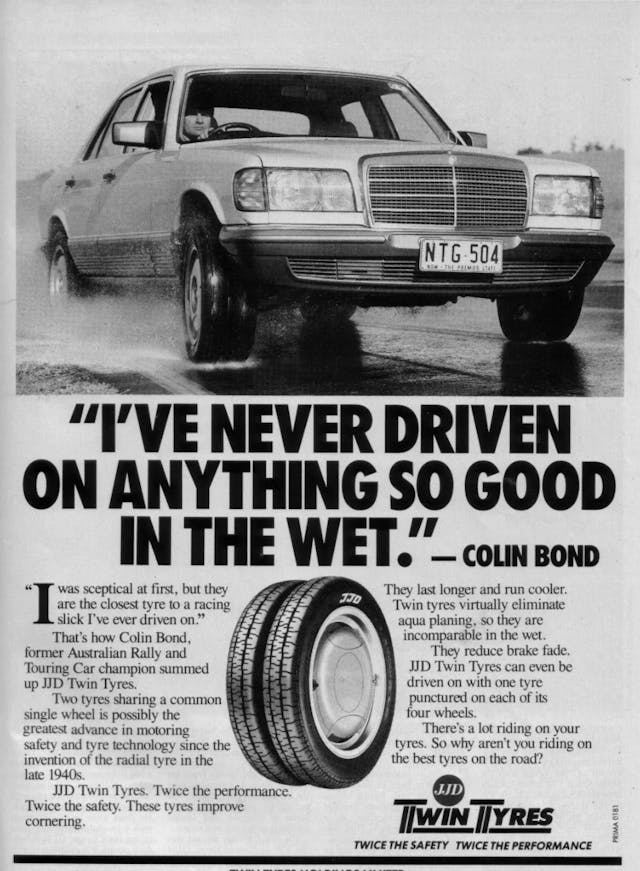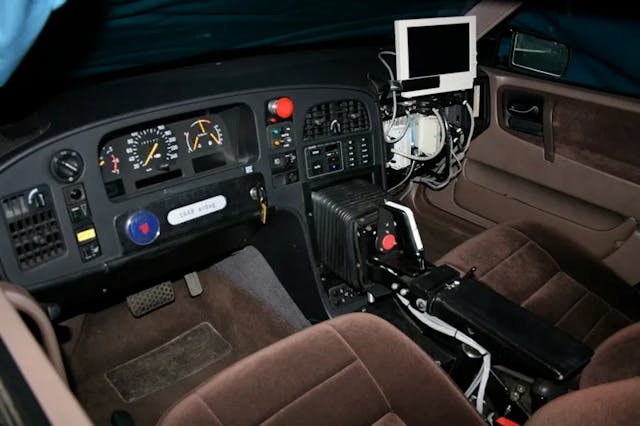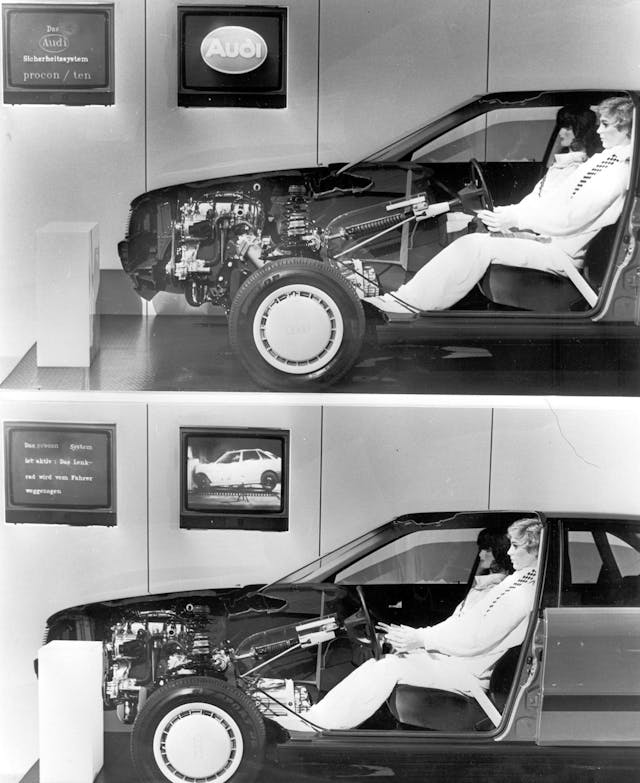Media | Articles
The “Pedestrian Scoop” and 6 Other Crazy Car Safety Ideas
Under Britain’s Red Flag Act of 1865, the burgeoning motor carriage was restricted to just two miles per hour in towns and four miles per hour on country roads. What’s more, it was required that every vehicle always had three people with it: one to drive, one to ride shotgun, and a third to walk in front carrying a red flag.
For 30 years, until the act was repealed, this was how car safety was enforced. But if you think that idea was daft, just wait until you see what else automotive inventors came up with.
The Safety Scoop
In 1939, two boffins in Sheffield, U.K. devised the Safety Scoop. Fitted to, or replacing, a car’s front bumper, the spring-loaded device would deploy a large fabric catcher to scoop up any pedestrians who weren’t paying attention.
“When the scoop is open a jaywalker simply can’t get run over—and sometimes that’s more than he deserves,” reported British Pathé. This wasn’t even the first time such a concept had been tried—with a similar setup demonstrated in Germany in 1927. Unsurprisingly, neither version took off.
Marketplace
Buy and sell classics with confidence
The Overtaking Aid
Passing a slower-moving car on a single-lane road has always been a potentially risky business. Is the road ahead clear and straight enough? Has the driver ahead noticed you? Is he or she about to turn off or stop? In 1936, in a bid to make overtaking safer, a British inventor came up with a roof-mounted sign so that the driver could indicate to the car behind whether it was safe to pass. However, the idea of taking said responsibility away from the overtaking driver was bonkers, not to mention it simultaneously gave the slower driver authority. Seems to be the perfect road rage recipe.
The Crab Car
Designed to diminish the danger of parking scrapes, the 1938 Crab Car, demonstrated in London, deployed a set of mounted trolley wheels so that the car could be driven sideways into a parking space. Apparently the idea was considered by Britain’s War Office, although perhaps the actual war got in the way of it being adopted. Today, the concept is back with tank-turning EVs such as the Hummer and Hyundai’s amazing axle-articulation. So maybe it was just ahead of its time.
The Tire Trolley
No time to fix a pesky puncture? Then a tire trolley shown in London in 1960 might just be the answer. The device, like the go-jacks used to move cars around shows or workshops, slid under the wheel and tire, allowing the driver to proceed. With what are, essentially, grocery cart casters now replacing one corner of your car, it must have been quite a handful at anything above a walking pace.
The Twin Tire

On the subject of tires, there have been many attempts to reinvent the rubber around things. Truck drivers have long been used to driving dualies with two pairs of wheels and tires on a rear axle, but in the 1980s, Porsche factory racing driver Jaroslav “Jerry” Juhan came up with the concept of having twin tires on a single wheel. The idea was that, in the rain, the channel between the two, narrower, tires would clear water better, while in the dry the contact patch wouldn’t be compromised. JJD Twin Tyres (sic) was the result, and Juhan even managed to get several wheel manufacturers—including ATS, Crimson, and Speedline—to sell compatible wheels, while the tires were available from Avon and Toyo. Despite its benefits, the additional cost and weight of the Twin Tyre setup meant it never made it to the mainstream.
The Joystick Car

If you think Tesla’s yoke is a joke, then what would you make of Saab’s attempt to do away with a steering wheel completely? In the early 1990s, the Swedish firm developed a version of its 9000 with a joystick mounted in the center console. Why? To remove the risk of the driver hitting the steering wheel in an accident. While sound in principle, the problem was that the setup was ridiculously difficult to drive. The stick operation was simple: twist left to go left and right to go right; but with 180 degrees of total movement, steering was super twitchy. The idea was abandoned. On the plus side, some other features of Saab’s “Prometheus” project, such as adaptive cruise control and infra red cameras, would become widely adopted safety features.
Procon Ten

Audi’s Procon Ten system was undoubtedly ingenious, but the arrival of airbags rapidly rendered it obsolete. Procon Ten, released in 1986, used a network of steel cables running around the rear of the engine and connected to the steering column and seat belt mounts. In the event of a frontal collision, as the engine was shunted backwards, the cables pulled the steering wheel away from the driver while the seatbelts were simultaneously tightened. Fitted to the Audi 100/200 and 80/90, it was axed by the time the A4, A8, and A6 arrived to replace them.
***
Check out the Hagerty Media homepage so you don’t miss a single story, or better yet, bookmark it. To get our best stories delivered right to your inbox, subscribe to our newsletters.














The crab car could have used some tread on the one front tire.
I remember the duel tires. They were all the rage for a short time. But like most other tire system if it relied on special wheels and higher cost it failed.
Like these air less tires we have now they are not new. I worked with them several decades ago. The trouble is cost and the inability to have wheels that can use them or inflated tires. I do not see these coming all that soon. They are fine for lawn mowers.
My Buick Tourx has a system that will blast the hood upward at the windshield edge (you read that correctly) to reduce pedestrian injuries. You should look this up.
Love ’em all!
While not safety mods per-se, the Little Rascals had a few goodies along the way, my favorite being the A-pillar-mounted crisscross “extender” with a boxing glove on its end. Wish I had one…
The Audi “Procon Ten” system continued through the later 90/100/200/C4 generation chassis’s in combination with airbags.
There are way too many safety features on the modern autos to the point where I do not enjoy driving them. I’ll stick with the older models.
GM worked on that joystick car thing as well around the same time, I still remember seeing the joystick being shown off at World of Motion at EPCOT in the late 80’s
Just wondering… is the “tiller” on some early Horseless carriages a proto-joystick???
The steering wheel on all cars has absolutely no function as a wheel. They are all tillers. They are tillers with a circular handle.
How about a hood mounted rocket launcher to take care of the *diots in front of you on the road? If 007 can have one…..
What driver of a car of the early ’50s wasn’t sighting down the tail of a rocket or a jet on his hood as he was speeding down the road.
Lincoln, MB, RR, Pontiac, Dodge, Plymouth, Desoto…
I had an ’89 Audi 100. Did I have Procon 10 without knowing?
I’d love to have one of those pedestrian scoops if I were to come up on some protesters blocking the roads. It could automatically flip them behind once you reach a speed of about 50.
We call them snowplows,
The Tire Trolley is a really good idea that with a little inginuity and engineering could be a cost effective and time saving device today. I like the dual tires too and again, with the right engineering and probably backing by one of the major automakers could be a hit today.
I like it too – for the rear wheels only! Wouldn’t want to try to stop the car with brakes on only one side of the front or steer in the same situation.
Plus if you hit a pot hole with those caster type wheels, It would take out the whole device.
Although impractical, many of these ideas addressed the same concerns as today. The pedestrian scoop = the front end designs of today’s cars to lessen pedestrian impact such as the “active bonnet”; the tire trolley = the run flat or self sealing tire; the overtaking sign = lane departure warning. While crude and ineffective, they started the process to improve safety.
One of the craziest devices I remember from childhood was the curb feeler. Crazy thing as they actually worked! Looked funny and I had fun walking down the sidewalk and twanging them as I walked by cars that had them installed.
I remember when I was a car crazy 13 year old kid I bought my older sister a set of curb feelers for her 66 Chevy impala convertible as a Christmas gift . She wasn’t too pleased ,lol.
I love the yolk idea.
It reminds me of when I was flying
helicopters.
I never really thought of the
helicopter cyclic stick being a safety
feature, since flying a Korean War surplus helicopter isn’t that safe to
begin with.
Your feet at the front of the plastic bubble are your crumple zones, above you are whirling blades and 2 fuel tanks are over your shoulders.
Come to think of it, a steering column is the least of your worries.
The 1912 Detroit Electric came with a ’tiller’ as well as many other early cars, like the similar Baker Electric. Worked fine at 20mph. Jay Leno has one he drives occasionally. They used iron-nickel Edison batteries.
heli – a whole lot of compromises flying in close formation
There is one crazy safety idea that actually became an option on the 69 Camaro.
It was called the Liquid Tire Chain Dispenser. It had a dashboard actuator and used vacuum lines to dispense an AC manufactured liquid polymer over the tops of your rear tires. The system required trunk mounted canisters for the liquid.
I remember those. Not that great in snow, but the liquid made a GREAT traction compound for SLOT CAR TIRES. Bought a case of it before GM dropped it, nobody else around here (N. IL) had any idea what I was using on my tires. Super advantage or several years. It even worked to help the silicone tires as it kept them cleaner.
Safety scoop could be modernized and called the protester removal scoop
Yes!
I think a snowblower attachment would be better for that.
I used to think car people were nice, helpful people. The more I read the comments section, the less I believe that.
Let’s hope they’re a minority.
Well, on the benefit side of the equation, some may actually be relevant today given the ever increasing inattention while driving. They’d certainly be easier to implement than a “self-driving” feature.